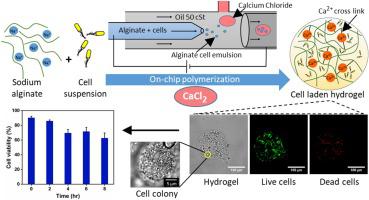Colloids and Surfaces B: Biointerfaces ( IF 5.8 ) Pub Date : 2021-08-24 , DOI: 10.1016/j.colsurfb.2021.112065 Md Danish Eqbal 1 , Farha Naaz 1 , Kajal Sharma 1 , Venkat Gundabala 1

|
Microfluidics based techniques for generation of cell-laden microbeads are emerging as an attractive route to 3D cell encapsulation due to the precise control provided by microfluidics. However, existing microfluidics based cell encapsulation methods are restricted to 2D planar devices and use of passive methods for droplet generation. In this work, we report the development of a 3D glass-PDMS (polydimethylsiloxane) hybrid device for complete on-chip generation of cell-laden alginate beads in the presence of electric fields. The 3D hybrid device allows application of electric fields for active control of droplet (sodium alginate) size without the need for electrode patterning or liquid electrodes. Chemical gelation is achieved through on-chip coalescence of sodium alginate droplets and calcium chloride plugs, generated using coflow and T-junction geometries respectively. Using this approach, we successfully encapsulate E. coli cells (with viability ∼90 %) into alginate microbeads and perform comprehensive spatio-temporal growth and viability studies. The active control of droplet size coupled with complete on-chip gelation demonstrated here is a promising technology for cell encapsulation with applications such as cell therapy, organ repair, biocatalysis, and microbial fuel cells.
中文翻译:

在存在电场和时空活力研究的情况下,基于微流体技术生成细胞封装的微珠
由于微流体提供的精确控制,基于微流体的用于生成载有细胞的微珠的技术正在成为 3D 细胞封装的有吸引力的途径。然而,现有的基于微流体的细胞封装方法仅限于二维平面设备和使用被动方法生成液滴。在这项工作中,我们报告了 3D 玻璃-PDMS(聚二甲基硅氧烷)混合装置的开发,用于在电场存在的情况下在芯片上完全生成载有细胞的藻酸盐珠。3D 混合设备允许应用电场来主动控制液滴(海藻酸钠)的大小,而无需电极图案或液体电极。化学胶凝是通过海藻酸钠液滴和氯化钙塞的片上聚结实现的,分别使用 coflow 和 T 型接头几何生成。使用这种方法,我们成功封装了大肠杆菌细胞(存活率约为 90%)转化为藻酸盐微珠,并进行全面的时空生长和存活率研究。这里展示的液滴尺寸的主动控制与完整的芯片凝胶化相结合,是一种很有前途的细胞封装技术,其应用包括细胞治疗、器官修复、生物催化和微生物燃料电池。


























 京公网安备 11010802027423号
京公网安备 11010802027423号